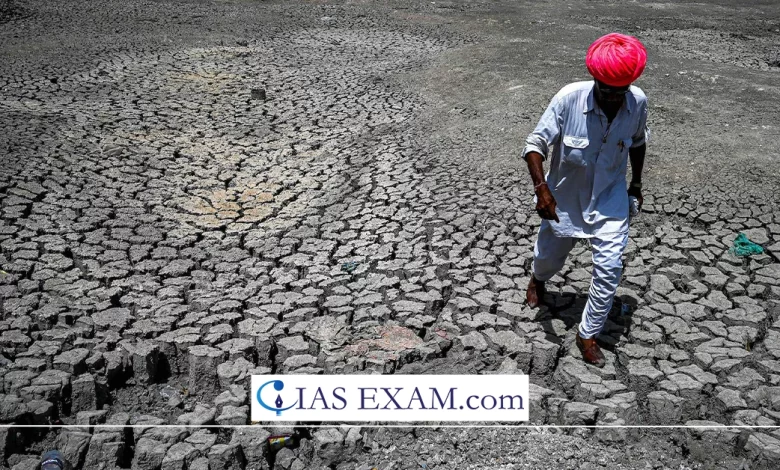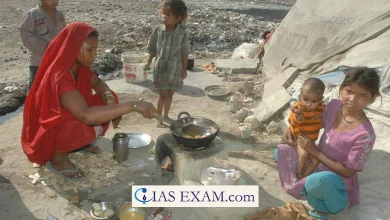Heatwaves Across India
Syllabus: Environment and Pollution [GS Paper-3]

Context
The Indian Meteorological Department (IMD) has issued a heatwave advisory and shared an alarming image showing the increasing intensity of heatwave conditions across several regions, including Rayalaseema in Andhra Pradesh and western parts of Madhya Pradesh.
Key Points
- India, known for its varied climates, is currently experiencing contrasting weather patterns.
- The India Meteorological Department (IMD) has predicted a heatwave in several states, while the northeast region is expected to receive rainfall.
- This diversity in weather possesses distinct challenges and highlights the ever-changing nature of India’s climate.
About Heatwave
- During the heatwave period there occurs a rise of hot weather above seasonal average, the phenomena which is marked by high temperature levels and high humidity.
- Consequently, these isolated weather events have the power to alter human health, infrastructures, agriculture and general ecosystems to a large-scale.
- The heat-related illnesses like heat exhaustion, heat stroke and dehydration can adversely affect the people who are in the risky age groups like elderly & children or people who spend much time outdoors.
- Heat waves make various services break down as well, i.e. power cuts, higher electricity demand, and traffic system failures.
- High amount of air pollution levels is often caused by the air masses which do not move much at all and keep the pollutants close to the surface of the ground.
- As for agriculture. Heat waves cause crop failure, decline in produce, and welfare cost for livestock.
- In order for the problem of heat waves to be addressed, solutions like drinking plenty of water, making trips under shade, developing green areas and researching appropriate emergency measures can be applied.
Heatwave Conditions
- A heatwave is when temperatures are extremely high, posing health risks and exceeding the usual seasonal average.
- The IMD has issued a warning for a heatwave in certain areas of India until April 7, which may cause uncomfortably warm nights.
- The definition of a heatwave varies, but generally refers to temperatures of at least 40°C or 4.5 degrees above normal.
- Heatwaves have various impacts on human health, agriculture, water supply, and wildlife.
Rainfall in Northeast India
- IMD forecasts that heavy rain and thunderstorms which started in Northeast India on April 6, shall continue up to April 9 in Assam, Arunachal Pradesh, Meghalaya, Manipur, Nagaland,Mizoram, and Tripura, that may help them.
- On the other hand, the rainfall sometimes overflows, watering some areas too much. The consequence is the dilution of soil and monsoon damages to crop production. These make draughts to some places strenuous conditions.
Preparation and Adaptation
- The dual forecast of heat and rain is significant as it allows residents and authorities to prepare for potential weather-related challenges.
- For the areas expecting a heatwave, it is essential to stay hydrated, avoid going out during peak heat hours, and take measures to cool down homes and public spaces.
- Conversely, in the northeast, preparations involve ensuring proper drainage to prevent flooding and securing outdoor belongings against strong winds and thunderstorms.
Climate Change Considerations
- Weather warnings in India are highlighting the increasing severity of climate change, with heatwaves becoming more frequent and intense.
- The contrast between extreme heat and heavy rainfall serves as a reminder of the importance of sustainable practices and the urgency for policies that promote climate resilience.
Conclusion
The current weather warnings from the IMD highlight the complexity of India’s climate and the need for vigilance and preparedness. As the country navigates through these contrasting weather conditions, the focus remains on safeguarding communities, preserving the environment, and building a sustainable future in the face of changing climate patterns. The coming days will be a test of resilience for the people of India as they adapt to the heat and welcome the rains.
Source: livemint
UPSC Mains Practice Question
Q.Discuss the socio-economic and environmental impacts of heatwaves in India. How can government policies, community resilience, and technological innovations be leveraged to mitigate the adverse effects of heatwaves and build climate resilience in vulnerable regions?





.png)



